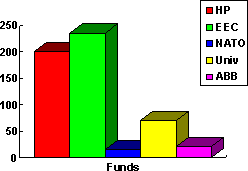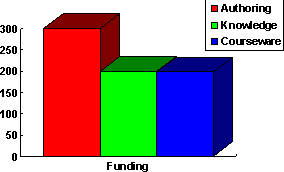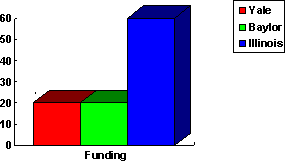In 1982 Rada was the recipient of a Wayne State University Research
Grant for Characterization of Search Spaces" ($5 thousand).
He was awarded a National Science Foundation Travel Grant of
$1000 to present his paper at the 1983 International Joint
Conference on Artificial Intelligence in Germany. In 1983
Rada received a National Science Foundation Engineering Research
Initiation Grant for ``Knowledge Acquisition for Medical Expert
Systems". The grant's monetary value was $50 thousand.
In 1984 Rada moved to the Lister Hill Center of the National Library
of Medicine as a Research Officer. He was given two researchers
to support his research efforts. In 1985 he was Editor of
Index Medicus and Chief of the Medical Subject Headings Branch.
He was also a director for the multi-million dollar Unified Medical
Language System project . Rada retained his research office
within the Lister Hill Center and was given a second office in
the library proper. The job of Editor of Index Medicus
included 1) being titular head of the production of Index Medicus
which involved a staff of 300 people and 2) deciding which
3,000 journals of the world's 20,000 should be covered by Index
Medicus. As Chief of the Medical Subject Headings Branch,
Rada directly controlled a staff of 12 professionals whose main
function was to maintain the massive 100,000 concept thesaurus
which was used to index the medical literature.
The National Library of Medicine is part of the United States
government and its employees are not allowed to apply for funds
from the National Science Foundation or any other sources. However,
a comparison to university funding that might have been obtained
can be estimated by looking at the resources which Rada controlled.
Rada was able to maintain the equivalent of about 4 full-time
research staff and 12 production staff. The salaries of the
research staff would be about $70 thousand per annum. The partial
control of multi-million dollar funded projects, such as the
Unified Medical Language System project, provided Rada control
over say $100 thousand per annum of research funding. Thus Rada's
research budget was $170 thousand per annum for the period 1984-1988
or a total of $680 thousand.
On his return to university work in 1988, Rada began in earnest
to acquire research funding. In his first efforts at the University
of Liverpool, Rada recruited Ph.D. students and then needed to
find funding for the students. Hewlett-Packard proved amenable
to providing such funding and a constructive relationship between
Rada's research group and Hewlett-Packard began. Hewlett-Packard
provided:
Equipment donation of 5 workstations, 2 personal computers,
file server, 500 megabyte disk, scanner, readable-writable optical
disk, and associated software ($100 thousand).
The Commission of the European Communities is the administrative
unit of the European Economic Community (EEC) and in an effort
to unite Europe is collecting taxes for research and re-distributing
them after very competitive peer-review to research and development
consortia. This EEC funding is comparable in Europe to what NSF
funding in the USA might be. In his first year in England Rada
succeeded in leading a consortium in winning an EEC research grant
to develop an intelligent document retrieval system.
In 1990-91 Rada also acquired several small contracts with the
EEC, the North Atlantic Treaty Organization (NATO), and the University
of Liverpool. The EEC contract was to develop thesauri. The
NATO grant was for numerous trips between Liverpool and Montreal
for researchers to collaborate across sites. The University
of Liverpool awarded Rada a New Professor's Fund for research
staff.
In 1992 Rada became involved in a large EEC project on software
reuse. This project brought $140 thousand to the University
of Liverpool. One of the partners in the project was Asea Brown
Boveri research laboratories in Heidelberg, Germany. Asea Brown
Boveri then provided Rada's group an additional research grant.
In summary form, the grants received during the 1988-1992 period
are:

-
Three Hewlett-Packard (HP) Ph.D. studentships, 1988-1992 ($100
thousand).
-
HP equipment donations, 1989-1991 ($100 thousand).
-
EEC Advanced Informatics in Medicine project for an intelligent
information system to connect patient records and medical literature,
1989-1990 ($75 thousand).
-
EEC grant for multi-lingual, multi-functional thesaurus, 1990
($20 thousand).
-
NATO Travel Award ($15 thousand) 1989-1992
-
New Professors Fund staff positions, 1992-94 ($70 thousand)
-
EEC ESPRIT project on software reuse, 1991 ($6 million project
of which my part was $140 thousand)
-
Research contract with Asea Brown Boveri (ABB) research laboratories
in Heidelberg, German for Software Reuse, 1992 ($20 thousand).
The total funding for this period is $540 thousand.
Rada continued
his efforts to work with the EEC, and in 1992 these efforts were
rewarded with two large EEC research contracts:
-
EEC Distance Education program for the Open-Systems for Collaborative
Authoring and Reuse project, 1992-1995 ($4 million project of
which Rada's part is $300 thousand).
-
EEC Advanced Informatics in Medicine program for a medical knowledge
base project, 1992-1995 ($5 million project of which Rada's part
is $200 thousand).
The work with the EEC Distance Education program coincided
with an emphasis in Rada's group on courseware development.
Educational technology can be particularly easily applied in a
computer science environment. Applying this technology to the
rather different health care environment gives another perspective
on its utility. Rada's group explored the application
of educational technology both in the university and within the
broad health care environment:

-
Enterprise in Higher Education project for collaborative learning,
1992 ($20 thousand).
-
Collaborator in Merseyside Regional Health Authority grant to
explore Clinical Audit, 1991-92 ($25 thousand).
-
National Health Service project to explore the development of
distance learning material on health care economics 1993-94 ($35
thousand)
-
Vocational Education Committee project to develop distance-learning
package for allied health professionals 1994 ($24 thousand).
-
Teaching and Learning Committee project for survey of university
courseware development, 1993-94 ($20 thousand)
-
British `Beyond Medical Courseware' Consortium, 1993-1995 ($3
million project of which Rada's part was $75 thousand).
These various projects have related to the broader interest of
Rada's research group in the role of groupware and hypermedia
in helping people.
The total funding to the University of Liverpool between 1992
and 1995 was $699 thousand.
In August 1995 Rada assumed the Boeing Distinguished Professorship of
Software Engineering at Washington State University. This position
includes an annual discretionary fund of $25 thousand.
Between September 1996 and May 1996, Rada was the Virtual University Academic Officer.
This position entailed considerable administrative work and was in some
ways like his work 10 years earlier at the National Library of
Medicine. For instance, he operated as a kind of project officer
for external donations to be distributed by competitive bid within
Washington State University. The resources to be thusly distributed
were worth about $1 million. Rada was also provided part-time
staff to help manage the project.
In the summer of 1996 NSF awarded a $51k grant to Mohammed Osman, Pat
Flynn, and Roy Rada for educational technology for a "Solid State Device
Animation Laboratory".
In January 1997 Rada assumed co-principal position in a 18-month contract worth
$500,000+ from the Paul Allen Virtual Education Foundation.
Rada was at Pace University for 1 year as a Professor of Computer Science and of Information Systems. He was recruited to co-lead the University's new online Associates Degree in Telecommunications that was funded by the Sloan Foundation "Asychronous Learning Networks" Initiative and all the major telecommunications companies of the US.
Roy had some start-up funding from UMBC and was Director of the Online Masters in Information Systems
which was created in co-operation with the British Open University and funded by both universities.
He was the principal investigator on a project funded by the Maryland Higher Education Commission (MHEC) to UMBC with partners
of Coppin State College and Microsoft Corporation. MHEC provided $200,000 to UMBC
and in kind contributions from the partners was $400,000. The project lasted from 2000-2002.
I have begun a new life in intelligent financial investing. I have obtained my first funding in this area in April 2008 as a Faculty Innovation Grant for $3,000 that must be spent by June 30, 2009 from the Alex Brown Center for Entrepreneurship at UMBC.
A $1,500 grant was obtained from the UMBC Undergraduate Research Fund to support Matt Schultz for Spring 2009 and Matt Jancasz in Fall 2009 for work in Intelligent Investing Systems.
I have also begun working in 2010 on research in sleep apnea.
I had a UMBC URAS Award for Spring 2010 that was spent on Scott Rothman. For Spring 2011 I also have a UMBC URAS Award for work on sleep apnea (that was awarded in October 2010).
In Fall 2013 I was a visiting scientist at Tabuk University, Tabuk, Saudia Arabia. My support included exactly air fare and accommodation in a trip that went as follows:
- first-class air fare from Dulles to Tabuk, from Tabuk to Signapore, and from Singapore to Dulles.
- first-class accommodation for 3 weeks.
Air fare cost $25,000 and accommodation cost $8,000 -- making this a support package worth $33,000.
I gave two keynote speeches at a conference on computer science education, visited several classes, and worked on a research proposal while in Tabuk. In Singapore I met with officials of the new Yale-National University of Singapore campus. The trip was from Nov. 11, 2013 through Dec. 5, 2013.
 Roy Rada was a Yale National Scholar (1969-1973) which guaranteed
whatever financial support could not be provided directly by his
family. He worked summers at Yale as a National Science Foundation
research student in the Psychology Department at Yale. At Baylor
College of Medicine Rada worked for the Department of Community
Medicine on a research project about the computerization of patient
records and funded by the National Institutes of Health (1974-1977).
Subsequently Rada was hired as a post-doctoral fellow at the
University of Illinois at Urbana where he did research and earned
a Ph.D. (1977-1981). (The Yale Univ. support amounted to about
$5,000 per annum and the research support at Baylor College of
Medicine was also approximately $5,000 per annum. The post-doctoral
research position at the University of Illinois at Urbana supplied
$20,000 per annum.).
Roy Rada was a Yale National Scholar (1969-1973) which guaranteed
whatever financial support could not be provided directly by his
family. He worked summers at Yale as a National Science Foundation
research student in the Psychology Department at Yale. At Baylor
College of Medicine Rada worked for the Department of Community
Medicine on a research project about the computerization of patient
records and funded by the National Institutes of Health (1974-1977).
Subsequently Rada was hired as a post-doctoral fellow at the
University of Illinois at Urbana where he did research and earned
a Ph.D. (1977-1981). (The Yale Univ. support amounted to about
$5,000 per annum and the research support at Baylor College of
Medicine was also approximately $5,000 per annum. The post-doctoral
research position at the University of Illinois at Urbana supplied
$20,000 per annum.).

